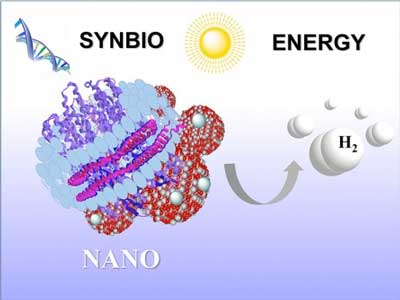| Posted: Nov 30, 2017 |
Photosynthesis without cells: Turning light into fuel
(Nanowerk News) An entirely human-made architecture that converts light into fuel was built at the Center for Nanoscale Materials. This architecture combines tiny, nano-sized and artificial biological structures. It uses water and sunlight to pump out hydrogen without need of high heat or pressure (ACS Nano, "Cell-free synthetic biology chassis for nanocatalytic photon-to-hydrogen conversion").
|
 |
| This schematic image shows the assembly of synthetic membrane proton pump (ribbon structure) with semiconductor nanoparticles (silver spheres) that produce hydrogen (H2) under white light illumination. (Image: Center for Nanoscale Materials)
|
|
Plants and other natural systems use energy to move protons across a cell membrane. The motion turns light energy into a cellular “fuel.” The elegance of this process inspires scientists to mimic it for new human-made materials and processes.
|
|
A human-made “proton pump” was built. It was then integrated with a tiny embedded titanium and platinum catalyst. The two parts work together to produce hydrogen under illumination. This structure could have practical uses in energy storage, catalysis, and artificial life systems.
|
|
At Argonne National Laboratory’s Center for Nanoscale Materials, a U.S. Department of Energy user facility, researchers employed artificial nanodisc membrane technology to develop a structure for converting light into hydrogen. The small nanodisc membranes assist the study of proteins structure.
|
|
In this case, the researchers sought to mimic nature’s proton pump machinery. The resulting proton pump was synthetically engineered cell-free, using nanodiscs as a membrane template to facilitate non-biological protein synthesis.
|
|
The team then integrated the nanodisc-protein structure with nanoclusters of a titanium oxide semiconductor and tiny dots of platinum co-catalyst (TiO2/Pt). In this form, titanium oxide is a strong conductor for chemical reactions involving light. Once this bioarchitecture was developed, a near constant transformation of light into hydrogen ensued for at least 2 to 3 hours.
|
|
This research could have practical applications in energy storage, catalysis, and artificial life systems.
|

